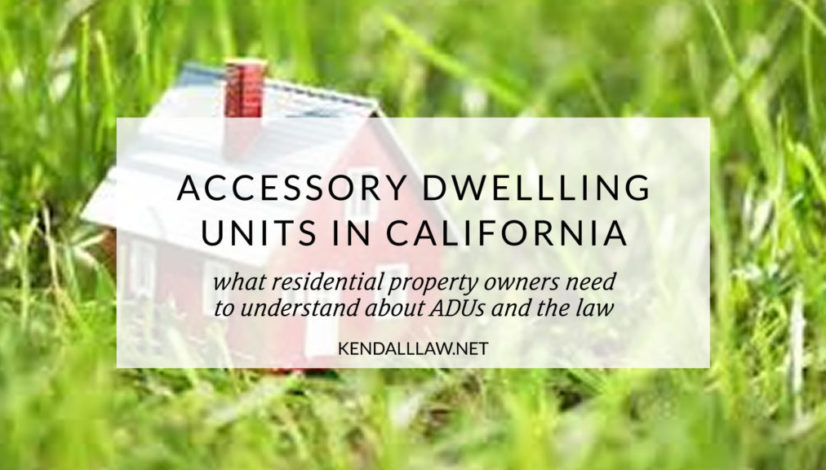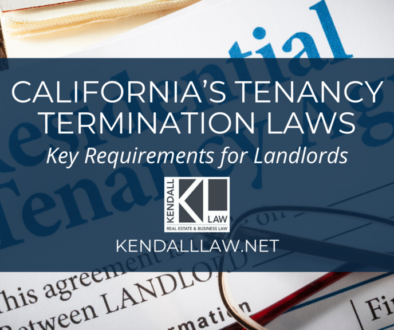Accessory Dwelling Units (ADUs) and the Law
California has struggled for a long time with a severe housing shortage. The passage of a slate of laws in 2019 targeted at Accessory Dwelling Units (ADUs) is the latest attempt to make a dent in this problem. An ADU is a small free-standing or attached structure that property owners can construct and lease as rental units. ADUs are complete independent living facilities for one or more persons (i.e., they have a kitchen and bathroom as well as a place to sleep). They are an innovative, affordable and effective option to increase the value and space of your house. They are typically smaller than 1,000 feet and are often called “granny flats,” “secondary units,” “mother-in-law apartments,” “backyard guesthouses,” “sidekick homes”, “in-law suites” or “cottages.” The fact that it’s a secondary housing unit—rather than a given structural form—is what defines an ADU. ADUs are affordable as they do not require paying for land, major new infrastructure, structured parking or elevators.
Here are some common traits shared by ADUs:
- They are accessory and adjacent to the main house
- They tend to be significantly smaller than the average U.S. house
- They tend to be one of two units owned by one owner on a single-family residence
- They tend to be primarily developed asynchronously from the primary house by homeowner developers
- A large range of municipal land use and zoning regulations differentiate ADU types and styles, and dramatically affect their allowed uses
Constructing an ADU can provide the following benefits:
- Adds overall value to the existing residence (also increasing the resale value of your home)
- Offers homeowners the opportunity to generate extra income
- Has less of an environmental impact than other housing options
- Decreases the need to expand infrastructure (i.e., roads)
- Allows neighborhoods to grow without drastically changing their overall character
- Creating more communal living, while still providing autonomy and privacy for both homes
- Family members can be nearby, but with privacy
The following is a summary of the bills passed in 2019 to regulate the construction of ADUs:
The goal of AB 68 and AB 881 is to streamline and expedite the approval process in order to facilitate the construction of additional ADUs. AB 68 restricts how frequently a city can say no when a homeowner applies for permits to build ADUs that are less than 850 square feet in size and 16 feet in height. Homeowners also have the option to add a second in-law unit on the property if there is space to construct the unit at least 4 feet away from property lines. In other words, a single-family home can be converted into a triplex.
- SB 13: Owner Occupancy and Fees:
SB 13 prohibits the enforcement of parking standards for ADU’s within ½ mile of public transit, requires ministerial approval of ADU permits within 60 days and allows construction of ADUs in garages and detached accessory structures. To further incentivize the construction of ADUs, SB 13 addresses one of the biggest barriers to the construction of ADUs—i.e., the fees associated with getting them approved and developed. Pursuant to SB 13, no impact fees can be imposed on ADUs smaller than 750 feet and any fees imposed on larger ADUs must be proportionate to their size. In addition, for 5 years, owners of ADUs are no longer required to live in the main dwelling while renting out the ADU, allowing a landlord to rent out both the main and the accessory unit.
AB 670 prohibits homeowners’ associations from banning or unreasonably restricting the construction of ADU’s on single family lots. AB 671 requires local General Plan housing elements to incentivize and promote the construction of affordable ADUs that can be rented to low and moderate income households. This package of laws aims to make ADU housing affordable to a wide variety of occupants.
SB 330 generally prohibits housing construction moratoriums, bars local governments from decreasing the amount of homes that can be built, and reduces the amount of time it takes to obtain a building permit.
The hope is that reduced barriers to ADU construction will ultimately spur further construction and lead to an increase in available housing. If you are interested in converting a unit located on your property into an ADU, you should consult with an attorney knowledgeable in this area to make sure that you are in compliance with the new laws. Contact Eileen Kendall at Kendalllaw.net to request a consultation. Eileen provides practical solutions for residential property owners and can be reached at (310) 619-4941.
Author: Eileen Kendall





